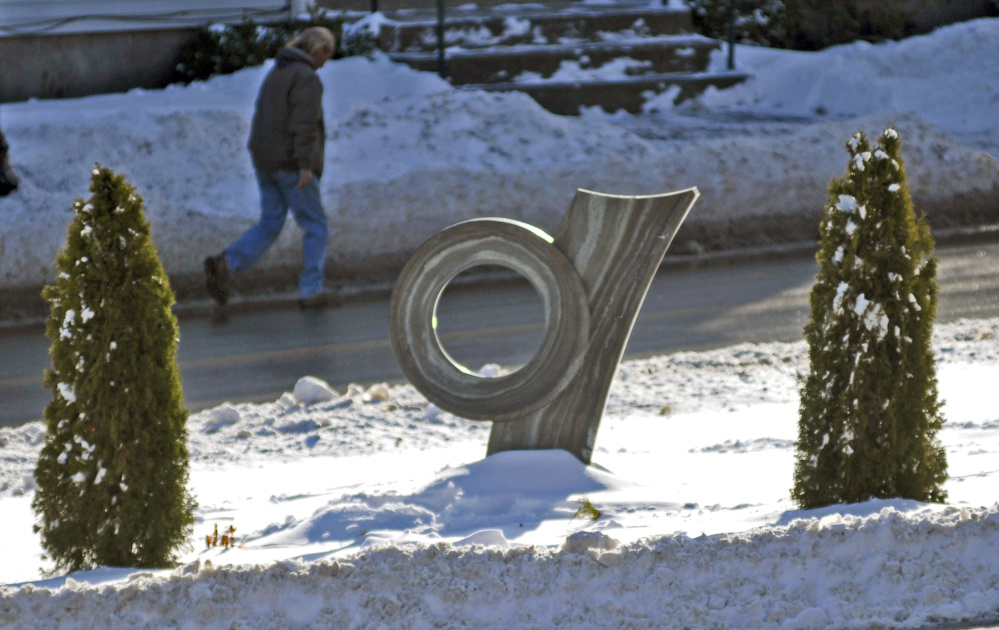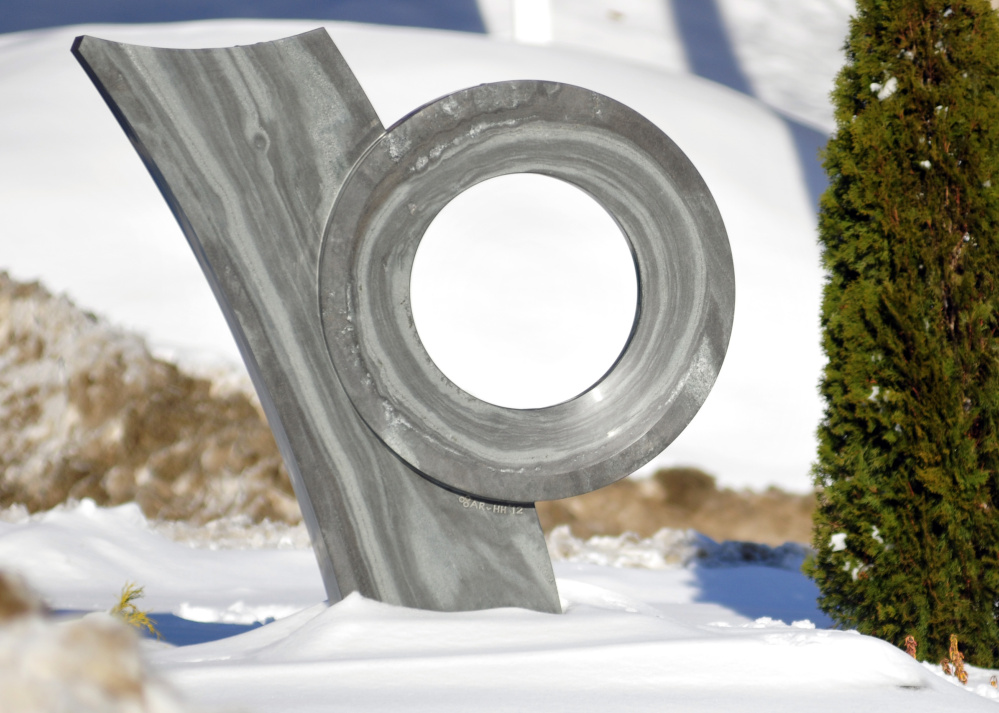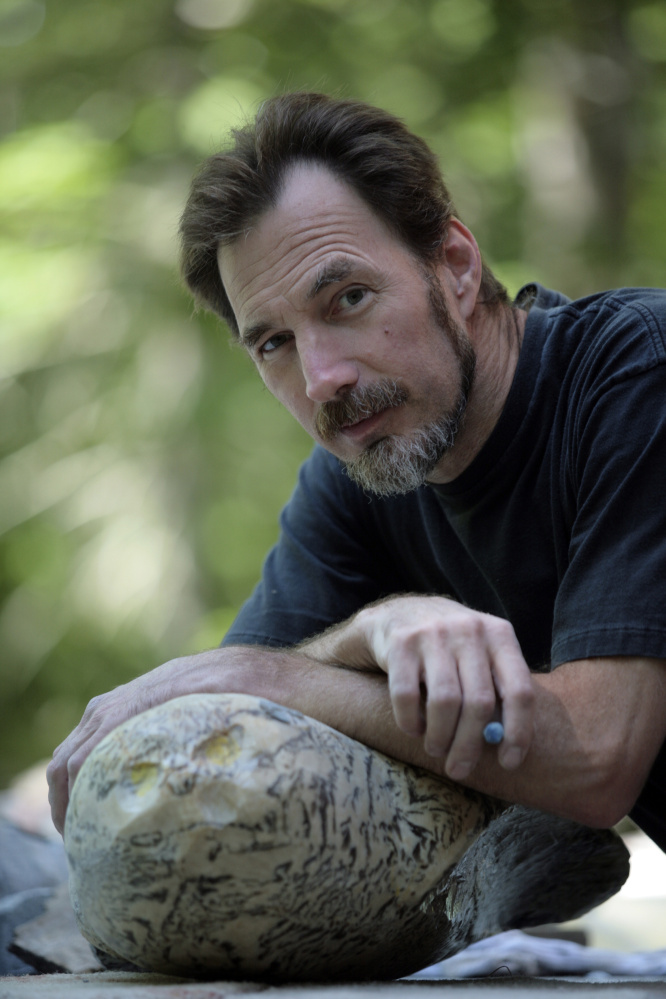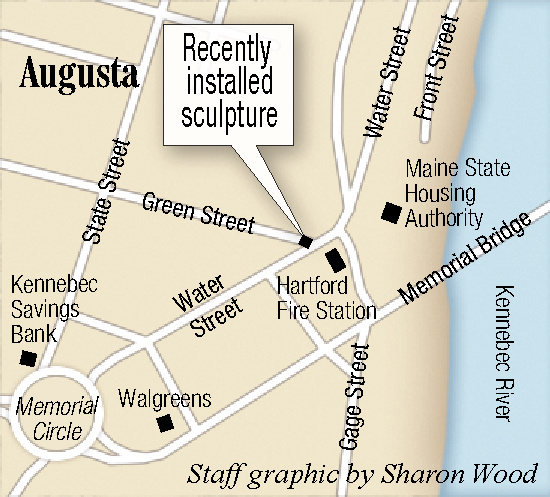AUGUSTA — The stone sculpture that was recently installed at the top of Water Street was, like many things in Maine, surrounded by snow on a recent afternoon. Even so, it was visible to the pedestrians braving buried sidewalks and the drivers leaving Memorial Circle to enter the downtown.
“Hey, what is that monument?” asked one woman rolling by in a wheelchair. “I’ve been wondering.”
The sculpture — a single piece of Micaceous quartzite carved into two shapes that roughly resemble the letter “P” — stands just opposite Hartford Fire Station. Michael Hall, director of the Augusta Downtown Alliance, explained to the woman that it was a piece of public art that was meant to welcome people downtown while also giving them a chance to interact with its abstract shape.
The piece used to stand at Viles Aboretum, and Hall gave a demonstration of how visitors there interacted with it: sticking their faces through the hole in its middle, whether for fun or photo opportunities.
This fall, the Augusta Downtown Alliance purchased the sculpture for $13,000 from Arrowsic artist Andreas von Huene, who originally crafted it in 2012 after acquiring the mineral from J.C. Stone in Jefferson. The group then donated it to the city for placement at the intersection of Water and Green streets.
This week, the City Council will formally decide whether to accept the donation, said City Manager William Bridgeo.
The donation, according to members of the Augusta Downtown Alliance, was part of a broader effort to improve the quality of life downtown and foster economic development.
In the coming year, Hall said, the alliance will be partnering with students and staff at University of Maine at Augusta to produce several murals. One would be visible to people entering the city, a second to people leaving the city and a third to people on the opposite side of the Kennebec River.
“This is just the tip of the iceberg,” Hall said of the recently installed sculpture. “It’s the main focal point for people coming in from the rotary. It’s to greet people coming down the hill and to give flavor to downtown Augusta, which doesn’t have a lot of art. 2017 is going to be the year of art.”
The Augusta Downtown Alliance purchased the sculpture using funds the organization has raised, Hall said. He added that there can be a correlation between the placement of artwork around cities and the revitalization of those cities’ downtowns. Part of Augusta’s inspiration for installing a sculpture came from Gardiner, which did the same last spring.
Tobias Parkhurst, chairman of the Augusta Downtown Alliance board, said the placement of the sculpture opposite the fire station was the result of cooperation between his group and the city, which renovated that intersection a few years ago and has also been considering ways to landscape and beautify downtown.
Introducing a sculpture and other artworks downtown is a small piece of a larger effort to bring restaurants, entertainment, culture and other offerings to the city, so that businesses may be more likely to set up headquarters here, Parkhurst said.
While the city has good business incentives and a track record of attracting stores, Parkhurst continued, “Now we need to focus on quality of life. If you want to be a great city, you have to look like a great city.”
Parkhurst appreciates the big box stores that have opened in Augusta, he said, “but it’s hard to be the commerce center of the state and look real good when branding is done by box stores. That’s not how we want to be known. We want to be known for our own brand that makes us unique.”
The group decided on which sculpture to buy and donate to the city by holding a vote, Hall said.
The voters chose appropriately — as it was the artist’s intention to give his sculpture a welcoming look. In an interview, von Huene said he wanted to give the piece “a welcoming presence” when he first made it.
“Instead of blocking the view of flowers (in Viles Aboretum), it would feature views of flowers,” von Huene said. “You could say the same thing for people. Instead of becoming a wall of people, it is amongst people and around them, because of the hole and the way the circle intersects the spine. It gives a lot of space.”
In its new location, von Huene said, the shape complements the views of Memorial Bridge and the Kennebec River.
“You can say it reflects the movement of that part of Augusta,” he said.
Charles Eichacker — 621-5642
Twitter: @ceichacker
Send questions/comments to the editors.








Comments are no longer available on this story